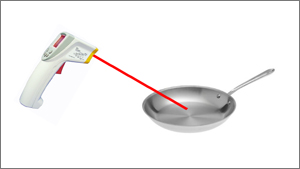Infrared Thermometer: The Kitchen Weapon You Need
by
 Just as the right piece of lab equipment can make our life easier, so too can the right kitchen tool. And if it just happens to make us feel like Dirty Harry when standing in front of the stovetop, all the better…
Just as the right piece of lab equipment can make our life easier, so too can the right kitchen tool. And if it just happens to make us feel like Dirty Harry when standing in front of the stovetop, all the better…
In the world of stovetop cooking, temperature is important to know. It dictates what oil we use and how long we cook. But how can we ensure the proper temperature if we have no idea what the “4” on our loose stove dial corresponds to?!
The first time I saw a digital IR thermometer in action was at a friend’s house during the preparation of his famous “Submission Salmon”. I was clearly out-scientist-ed by my non-scientist friend! This was a level of accuracy any scientist would envy. Within seconds of aiming and pulling the trigger, a digital IR thermometer will display the temperature to the degree. No more mystery. No more burned chicken breasts.
How do infrared thermometers work?
Unless we’re cooking at absolute zero, the molecules in the materials we’re using are moving and therefore emitting infrared radiation. As the temperature increases, so does the molecular movement and the level of radiation emitted. In fact, as evidenced by the Stephan-Boltzmann Law, small increases in temperature have profound effects on the amount of infrared radiation produced.
E=sT4
where,
- E= quantity of heat radiated per unit surface area
- s = Stephan-Boltzman constant
- T = Absolute temperature
While the red laser look cool, it serves no other purpose than to indicate where we’re aiming the gun. Instead, IR thermometers focus the radiation emitted by the target onto a detector, referred to as a thermopile. As the thermopile absorbs the IR radiation, it turns it into heat. The heat is then converted into an electric signal, which is ultimately used to calculate the temperature of the object.
Digital IR thermometers can be found in the $40-50 range. It’s the custom leather holster that’s gonna set you back…

